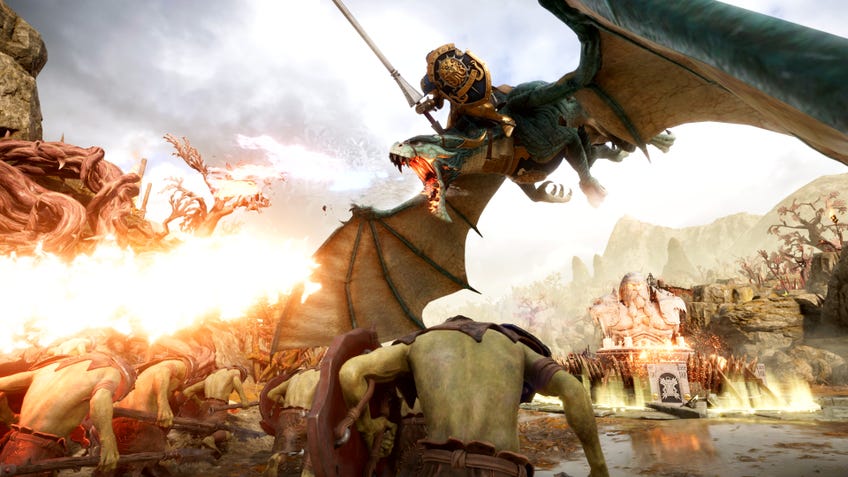Warhammer: Age of Sigmar’s first RTS Realms of Ruin is a very promising successor to Dawn of War 2 - hands-on impressions
Worth the waaaagh-t?
Warhammer is a game of two scales. On the one hand, you have enormous, multiple-thousand-point armies that swallow a tabletop in dozens of models, pages of rules and feet of rulers. The kind of setups that turn a weekend into the miniaturised equivalent of the 100 Years’ War.
On the other, you have the individual heroes, characters and small squads spotlighted by the likes of Warhammer’s tie-in Black Library books, recent skirmish spin-offs like Underworlds and Kill Team - where a handful of figures is plenty - and many of its video game adaptations, which prefer to put the player in control of a single named protagonist rather than hundreds of nameless troops. (It’s probably for the best you’re not on first-name terms, given the typical lifespan of a cannon-fodder goblin.)
Upcoming real-time strategy game Realms of Ruin - the first such RTS for Warhammer’s fantasy universe since it rebooted as Age of Sigmar almost a decade ago - aims to split the difference somewhat. You oversee command of up to 16 separate squads, each comprising a handful of units from one of four Age of Sigmar factions, but each squad is designed to feel unique and individual. It’s not quite the unit-spamming mass carnage of classic RTS like Age of Empires, but sees you fighting on more fronts than the single-character perspective of video games like Vermintide. Even so, there’s a clear focus put on using a small handful of troops to the best of their abilities, learning their unique advantages and disadvantages inside-out to emerge victorious.
Ahead of Realms of Ruin’s open beta, which launches this Friday July 7th, I was able to spend a couple of hours with both the first mission in its single-player campaign and three one-on-one multiplayer matches. The two factions I was able to play as - the Stormcast Eternals and Orruk Kruleboyz - and the multiplayer map are the same as those you’ll be able to play for yourself during the open beta.
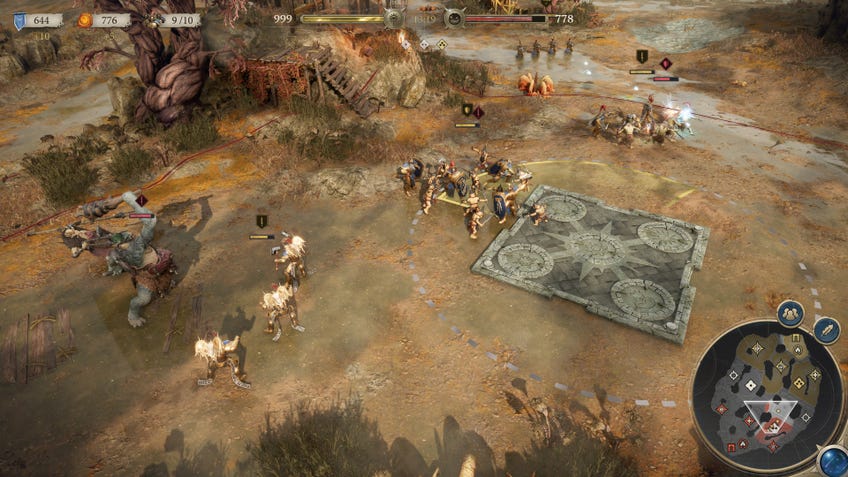
While developer Frontier bills Realms of Ruin as an RTS in the traditional vein, that’s not quite apt. For one, there’s no real base-building in Realms of Ruin. You start with a main HQ, which you can upgrade across three levels to grow your population cap and unlock more advanced units, such as the Stormcast Eternals’ dragon-like Stormdrake and the Orruks’ giant Troggoth, but there’s no option to build additional buildings alongside it or relocate closer to your opponent. Any troops you buy emerge from a portal on your fixed starting edge before trekking across the map, making it more akin to a MOBA like Dota 2 or League of Legends.
Combat is simple enough to not feel overwhelming, but still presents plenty of interesting variety.
While there’s no base-building as such, you will still be doing some building. Central to Realms of Ruin are capture points dotted around the map, which provide either the dominance needed to win by reducing your opponent’s score to zero - the more points you hold, the faster that number falls - or the key resources of command and realmstone used to buy units, purchase upgrades and trigger unique abilities. Once you take an arcane conduit by standing your troops next to it for a bit, you can build a bastion on it - allowing you to harvest more realmstone, provide defence against opponents, heal allies or expand your vision of the map. Before your opponent takes back the point, they’ll need to destroy the bastion.
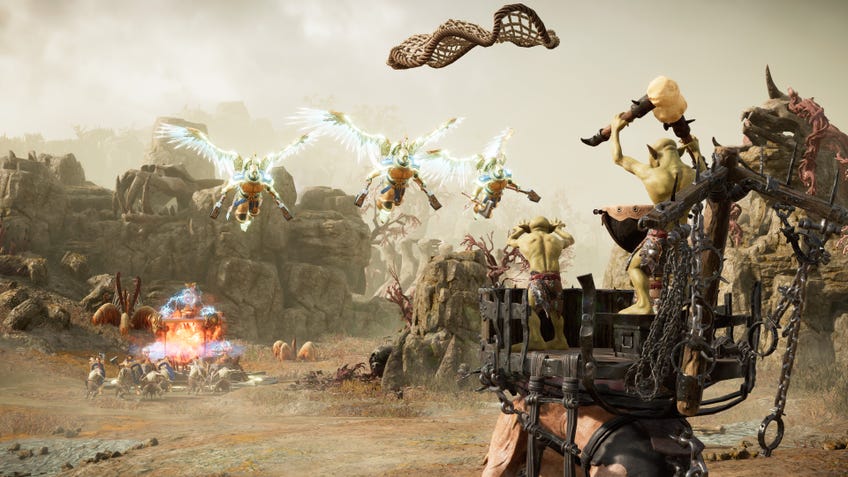
This is the main tug-of-war in Realms of Ruin; holding capture points to outpace your opponent’s unit production and upgrades, while also wrestling over the capture points needed to drain their victory points to zero first. Rather than racing to expand your base and amass units, it’s a fast-paced but strategic battle of individual squads over individual points where deploying units’ unique abilities - at the precious cost of realmstone, encouraging thoughtful timing - can quickly swing the tide in your favour.
These abilities feel potent and well worth the cost, from sending enemies flying with a Troggoth’s swing, smashing down from the sky with winged Stormcast Prosecutors, burning through using a Stormdrake’s fire breath to carving through a crowd with a penetrating ballista shot. Other abilities offer passive buffs, such as armour, health and defence, opening up the potential for powerful combos when squads and heroes are mobilised to take a point together.
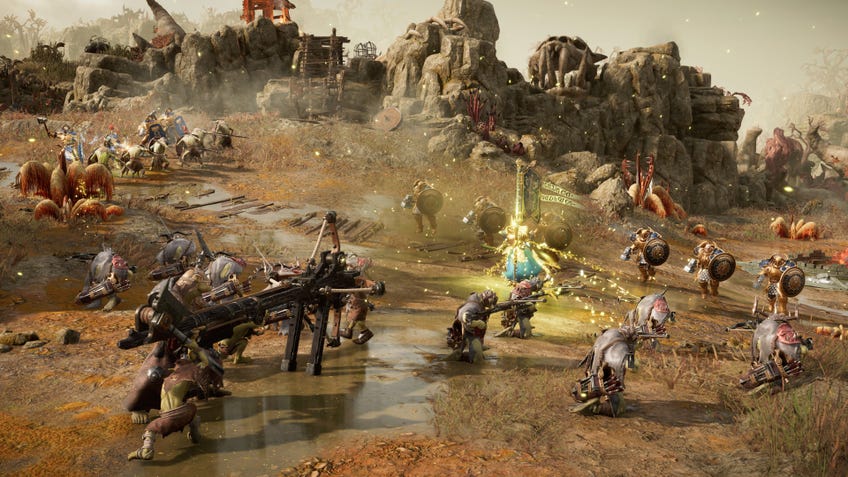
Combining troops is often key, too, as combat centres on a rock-paper-scissors dynamic between three core unit types: fast melee assault troops, ranged but weak shooters and tough but slow heavy units, plus unique heroes that lie outside of the combat triangle. Throwing troops into a poor match-up will see them quickly demolished, inviting careful consideration of when and who to fight with. It’s simple enough to not feel overwhelming, but still presents plenty of interesting variety - especially when mixed up with other abilities, such as flying, which sees airborne troops unable to directly engage with ground troops until landed.
Realms of Ruin feels tight and focused in the right ways, with brisk matches and a manageable scope that offers a satisfying amount of depth.
This is cemented by the game’s retreat mechanic - assigned to a dedicated hotkey - that will send troops back to base when hit. It’s often better to run and regroup than just watch a squad get creamed. That said, the same button is used to charge a squad into battle and (at least on keyboard) sits next to the button used for certain unit abilities, resulting in a couple of occasions where I awkwardly yoinked troops out of the action and had to wait for them to slink back to base while I was still getting acquainted with the controls. (Frontier is touting its new DirectStep controller scheme as seamlessly bringing a PC-level of control to PlayStation and Xbox consoles, but I played with mouse and keyboard.)
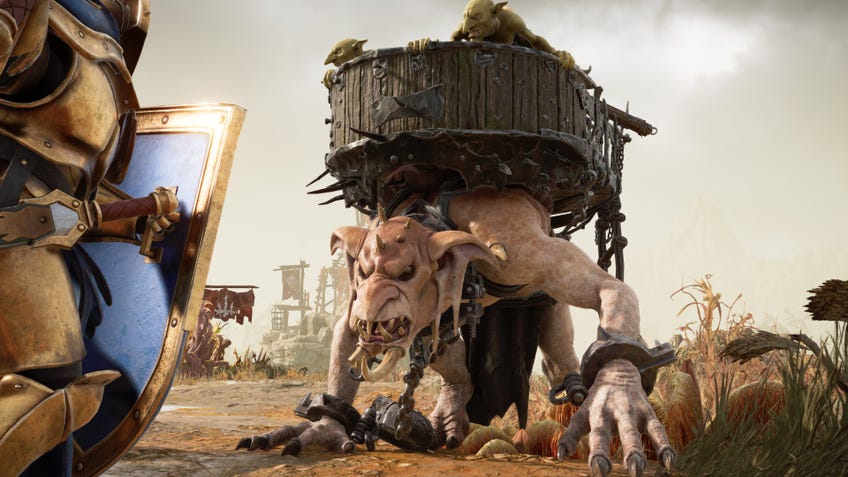
The closest comparison during my limited time with Realms of Ruin so far is to Warhammer 40,000 video game Dawn of War 2, which eschewed the classic RTS base-building of its predecessor and games such as StarCraft and Age of Empires in favour of an RPG-lite focus on upgrading characters, picking abilities and equipment wisely, and constantly fighting to control points on the map rather than just bulking up your army at HQ before slamming it into opponents. It’s arguably even more stripped back than Dawn of War 2, too, with no Company of Heroes-style terrain cover system and a fairly straightforward tech tree to progress along during each match.
That’s a positive comparison. Realms of Ruin feels tight and focused in the right ways, with brisk matches lasting under half an hour - half of that in a couple of cases where I managed to get the upper hand over my opponent - and a manageable scope that offers a satisfying amount of depth in which units you build and how you spec them via upgrades, without feeling overwhelming for RTS newcomers. While it’s hard to judge the longevity of the game without seeing how all four of its planned factions will interact, the three matches I played using the Stormcast Eternals and Orruk Kruleboyz left me keen to poke around with the possible unit and upgrade combinations.
The single-player mission I played before jumping into multiplayer was fairly basic, serving as a tutorial to get to grips with the basics of the game’s controls. Even so, its cutscenes - featuring Sigmar leader Sigrun and her squad of Eternals - looked fairly polished and cinematic, especially for a game where most of the time you’re watching from far above in the sky.
So far, Realms of Ruin finds its place between Warhammer fans picking up their first video game and video game fans curious to delve into the Mortal Realms.
The half-hour mission itself was very much an introductory scenario, built around learning how to guide a squad around a map, fight Orruks, learn how to use abilities - in the case of the Stormcast Eternals’ Vanguard Hunters, by sneaking past enemies - and capture points. With Black Library veteran Gav Thorpe lending his pen to Realms of Ruin’s campaign and the promise of a story faithfully rooted in Age of Sigmar lore, I’m hopeful that later missions will dig a bit deeper into the game’s characters and their place in its universe.
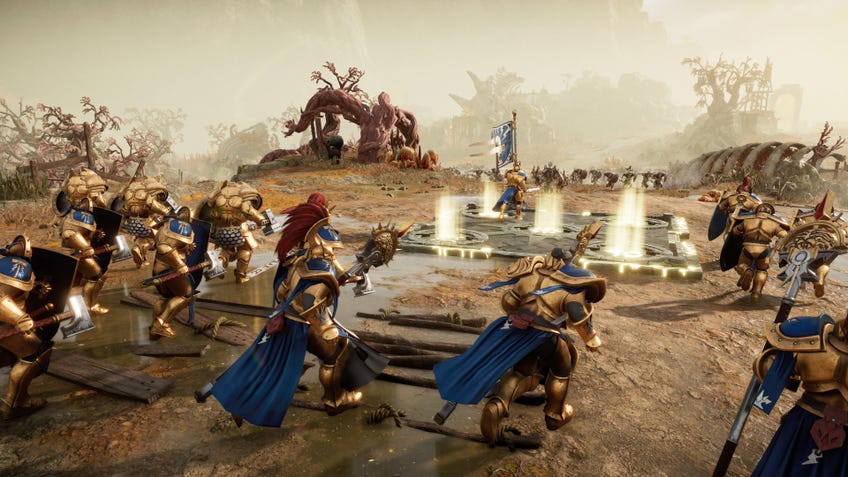
My time with Realms of Ruin left me optimistic about Age of Sigmar’s RTS debut. So far, this feels like a game that strikes the right balance between those classic PC games and the genre’s modern successors, as well as finding its place between Warhammer fans picking up their first video game and video game fans curious to delve into the Mortal Realms.
You’ll be able to form your own opinions when the open beta launches this Friday, ahead of Realms of Ruin’s currently unannounced release date.
